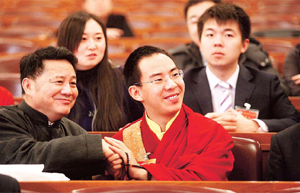Full text: Report on national economic, social development
(Xinhua)
Updated: 2010-03-16 14:14
7. We made notable progress in improving people's well-being and promoting harmony.
We further strengthened work concerning employment and social security. The central government allocated 42.6 billion yuan to promote employment, an increase of 59%. An additional 11.02 million urban jobs were created, 2.02 million more than planned. The urban registered unemployment rate stood at 4.3%, thus meeting the target of keeping it under 4.6%. Employment rate for college and university graduates this year was 87.4%. The number of rural migrant workers totaled 145 million, an increase of 4.92 million. Central government spending on social security was 290.575 billion yuan, an increase of 16.6%. Overall planning for basic old-age insurance for workers of urban enterprises at the provincial level was basically accomplished. The methods for transferring old-age pension accounts for workers who move from one region to another were promulgated and implemented. The number of urban residents covered by basic old-age insurance reached 235 million, 7 million more than planned. The pilot program for a new old-age insurance system for rural residents was launched. The basic medical insurance system for non-working urban residents was fully implemented. The problem of medical insurance for retirees from closed or bankrupt SOEs was properly resolved. The number of participants in the basic medical insurance for urban workers and non-working urban residents increased by 82.39 million to exceed 400 million; and the number of rural residents who signed up for the new type of rural cooperative medical care system increased by 16.3 million to reach 833 million. Standards for enterprise retirees' pensions, urban and rural subsistence allowances and subsidies to entitled groups continued to increase. Channels were further expanded for the funding of social security.
People's living standards continued to improve. We further developed the infrastructure in urban and rural areas and continually improved our ability to provide services. Supplies of goods and materials were abundant and the market was prosperous and stable. Annual urban per capita disposable income and rural per capita net income reached 17,175 yuan and 5,153 yuan respectively, up 9.8% and 8.5% from the previous year, both in real terms after adjusting for price changes, and 3.8 and 2.5 percentage points higher than planned. Great success was achieved in the current stage of our plan for low-income housing construction. The central government allocated 55.056 billion yuan for this purpose, an increase of 200%. As a result, 2 million units of low-income housing of various types were basically built, and 1.3 million houses were renovated in run-down areas in some cities, in state-owned forest regions and land reclamation zones, and around coalmines, thus improving living conditions for nearly 10 million urban residents experiencing difficulties. We allocated 5.6 billion yuan to work-relief schemes and 1.8 billion yuan to the pilot program for relocating impoverished people from inhospitable areas. These funds supported poor areas in strengthening their ability to develop and poor people in alleviating poverty. Policies for providing ongoing aid to rural residents relocated to make way for the construction of large and medium-sized reservoirs were conscientiously implemented, benefiting 23.56 million relocated people.
Social programs progressed in an all-round way. Infrastructure development for social programs was strengthened. Since the fourth quarter of 2008, central government funding for the development of social program infrastructure exceeded 55 billion yuan, more than the total for the whole Tenth Five-Year Plan period (2001-2005). Policies for free compulsory urban and rural education were fully implemented, and projects to renovate rural junior secondary school buildings in the central and western regions and to ensure the safety of primary and secondary school buildings across China were energetically carried forward. A total of 6.7 million square meters of rural junior secondary school buildings were renovated, and 3.14 million square meters of secondary vocational school buildings and special education school buildings were built. The junior secondary school retention rate rose by 0.3 percentage points to reach 94%; secondary gross enrollment ratio reached 79.2%, up 5.2 percentage points, and 2.2 percentage points higher than planned; regular undergraduate enrollment reached 6.395 million, an increase of 318,000, and 105,000 more than planned; and graduate enrollment totaled 511,000, an increase of 65,000, and 36,000 more than planned. Development of community-level medical and health care services and family planning facilities was further strengthened. A total of 17,171 community-based medical and health care clinics were set up; 4,522 community-level family planning service programs were established; and work relating to prevention and control of influenza A(H1N1) proceeded in a lawful, scientific and orderly way. The natural population growth rate was 0.505%, meeting the goal of keeping it under 0.7%. Construction of major cultural projects such as the National Museum of China and the second phase of the National Library of China proceeded smoothly. A total of 5,062 multipurpose cultural centers in towns and townships were built, and 1,444 public cultural facilities including museums, art galleries, and libraries were opened to the public for free. Radio coverage was extended to 96.3% of the population, and television coverage was extended to 97.2%. The tasks in the Eleventh Five-Year Plan to extend radio and TV coverage to every village were completed one year ahead of schedule. The targets in the plan for developing key tourist sites concerning the early history of the CPC were fully achieved. Philosophy, the social sciences, the press, publishing, literature, art and sports all flourished. The Eleventh National Games were successfully held. Construction of the Shanghai World Expo Park was basically completed.
Great progress was achieved in the current stage of implementing the plan for recovery and reconstruction following the Wenchuan earthquake. Investment of 654.5 billion yuan has been made in the most seriously affected areas, accounting for 65.5% of the total investment allocated in the plan. The rebuilding of rural houses was basically completed; rebuilding and reinforcing of urban houses were fully carried out; building of schools, hospitals and infrastructure proceeded smoothly; and reconstruction of Beichuan, Wenchuan and Qingchuan county seats and severely hit towns such as Yingxiu and Hanwang was sped up. The protection of cultural heritage in quake-hit areas was strengthened. Remarkable progress was achieved in one-to-one assistance.
In the context of the international financial turbulence, global economic recession, and grim and complex situations at home and abroad, we completed the main tasks specified in the 2009 plan for national economic and social development well. This achievement did not come easily. It was the result of the scientific response and strong leadership of the Party Central Committee and the State Council and the enormous concerted efforts of the whole nation from top to bottom in thoroughly applying the Scientific Outlook on Development and fully implementing the package plan for responding to the global financial crisis and relevant policies and measures. It was also attributable to the political advantages of the socialist system, which enables the country to mobilize the public, make efficient decisions, and concentrate resources on accomplishing major tasks.


